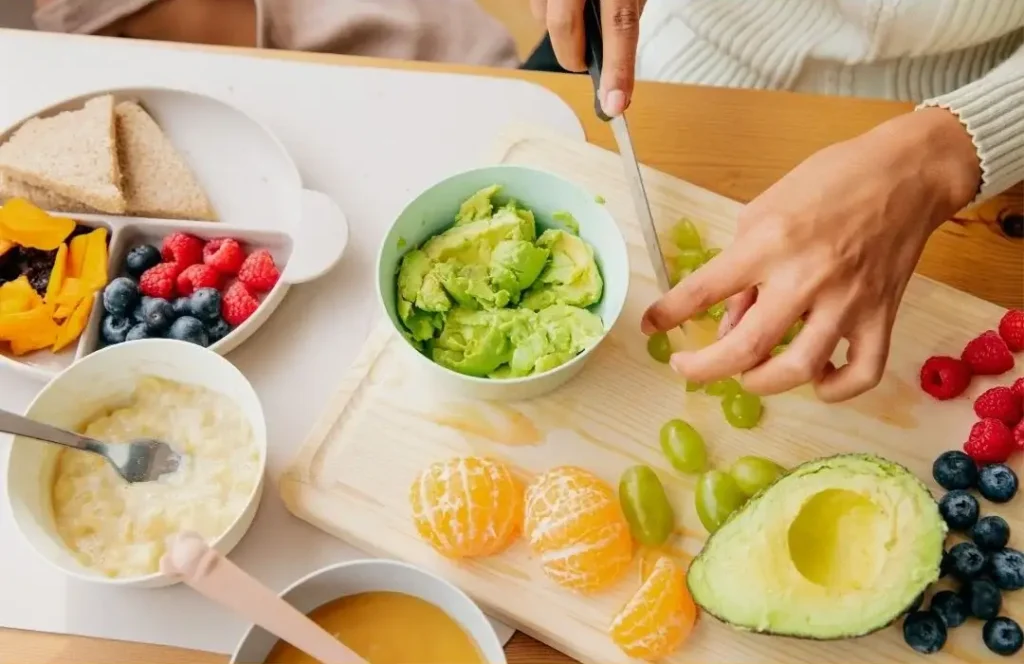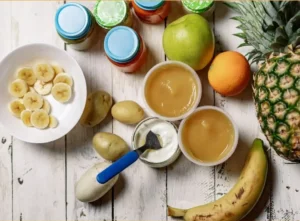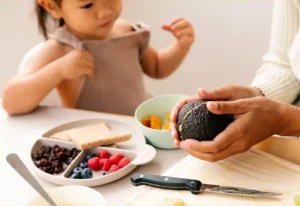Welcome to our website. If you are searching the knowledge about baby foods according to their various ages, you are at the right place. We have prepared some baby food charts according to the ages which will help you better.
0 to 3 Months Baby Food Chart

Weeks 1-4: Breast Milk Feeding
- Breast Milk: Newborns should ideally be exclusively breastfed. Feed on demand, whenever the baby shows hunger cues (rooting, sucking on fists, or crying). Aim for 8-12 feedings per day.
- Formula Feeding: If you’re using formula, follow the instructions on the packaging for the appropriate amount. Generally, newborns drink about 2-3 ounces (60-90 ml) per feeding, every 2-3 hours.
Weeks 5-8: Breast Milk Feeding
- Continue to feed breast milk or formula every 2-3 hours, adjusting the quantity as your baby’s appetite grows. Most newborns will gradually increase to 3-4 ounces (90-120 ml) per feeding.
Weeks 9-12: Breast Milk Feeding
- Your baby may begin to show signs of increased appetite. Continue feeding every 2-3 hours, and the quantity may increase to 4-5 ounces (120-150 ml) per feeding.
In this article, you will read
0 to 6 months baby food chart
0 to 1 Month: Breast Milk or Formula
- Newborns should be exclusively breastfed or formula-fed. Feed your baby whenever they show hunger cues, which could be every 2-3 hours. Typically, they may consume about 2-3 ounces (60-90 ml) per feeding.
1 to 2 Months: Breast Milk or Formula
- Continue exclusive breastfeeding or formula feeding. Babies may gradually increase their intake to about 3-4 ounces (90-120 ml) per feeding. Feed on demand, usually every 2-3 hours.
2 to 4 Months: Breast Milk or Formula
- Still, breast milk or formula is the primary source of nutrition. Babies may consume around 4-5 ounces (120-150 ml) per feeding every 3-4 hours.
4 to 6 Months: Introduction of Solid Foods
- Around 4-6 months, you can begin to introduce solid foods as your baby shows signs of readiness. Start with single-grain infant cereal mixed with breast milk or formula. Begin with a small spoonful and gradually increase.
- Introduce apples, pears, bananas, and vegetables such as sweet potatoes, carrots, and peas.
- Continue breastfeeding or formula feeding alongside solids.
- Gradually increase the variety of foods and the thickness of the purees as your baby becomes more accustomed to eating.

4 months baby food chart India
Weeks 16-17: Introduction of Solid Foods
Note: Breast milk or formula should continue to be the primary source of nutrition at this stage.
Day 1-2: Single-Grain Cereal (Rice or Oatmeal)
- Mix 1-2 teaspoons of rice cereal with breast milk or formula to make a thin, runny consistency. Offer a small amount with a spoon.
Day 3-4: Rice Cereal
- Continue with rice cereal but gradually make it slightly thicker.
Day 5-6: Rice Cereal
- Increase the quantity of rice cereal to around 2-3 tablespoons mixed with breast milk or formula.
Weeks 18-19: Introduction of Pureed Fruits and Vegetables
Ensure the food is pureed to a smooth consistency.
Day 1-2: Mashed Banana
- Mash a ripe banana until it’s smooth and offer a small amount.
Day 3-4: Apple Puree
- Peel, core, and cook a small apple until soft, then blend it into a smooth puree.
Day 5-6: Carrot Puree
- Boil and puree a peeled and chopped carrot until smooth.
Weeks 20-21: Expanding the Variety
Day 1-2: Mashed Sweet Potato
- Steam or boil sweet potato and mash it until smooth.
Day 3-4: Mashed Peas
- Cook peas until tender, then mash or puree them.
Day 5-6: Mashed Papaya
- Mash a ripe papaya and offer a small amount.
4 months baby food recipes
1. Rice Cereal Puree:

Ingredients:
- 1 tablespoon of rice cereal
- 4-5 tablespoons of breast milk or formula
Instructions:
- Mix the rice cereal with the breast milk or formula until you achieve a smooth, thin consistency.
- Spoon-feed your baby this mixture, starting with a small amount and gradually increasing the quantity as your baby gets used to it.
2. Apple Puree:
Ingredients:
- 1 apple, peeled, cored, and chopped
- Water for boiling
Instructions:
- Boil the chopped apple in water until it’s soft and tender.
- Drain any excess water and blend the apple to a smooth puree using a blender or food processor.
- Let it cool and then feed it to your baby in small, manageable amounts.
3. Banana Puree:
Ingredients:
- 1 ripe banana
Instructions:
- Peel the banana and mash it well until it turns into a smooth puree.
- Ensure there are no lumps and offer this puree to your baby.
4. Carrot Puree:
Ingredients:
- 1 carrot, peeled and chopped
- Water for boiling
Instructions:
- Boil the chopped carrot until it’s soft and easy to mash.
- Drain the water and mash the carrot to make a smooth puree.
- Allow it to cool and serve it to your baby.

5 months baby food chart for Indian
Weeks 20-21: Introduction of Solid Foods
Note: Continue to provide breast milk or formula as the primary source of nutrition.
Day 1-2: Rice Cereal (Rice Kanji)
- Mix 1-2 tablespoons of rice cereal with water or breast milk to make a thin porridge (rice kanji). Offer a small amount with a spoon.
Day 3-4: Rice Cereal (Thicker)
- Continue with rice cereal but make it slightly thicker.
Weeks 22-23: Introduction of Pureed Fruits and Vegetables
Ensure the food is pureed to a smooth consistency.
Day 1-2: Mashed Banana
- Mash a ripe banana until it’s smooth and offer a small amount.
Day 3-4: Apple Puree
- Peel, core, and cook a small apple until soft, then blend it into a smooth puree.
Day 5-6: Carrot Puree
- Boil and puree a peeled and chopped carrot until smooth.
Weeks 24-25: Expanding the Variety
Day 1-2: Mashed Sweet Potato
- Steam or boil sweet potato and mash it until smooth.
Day 3-4: Mashed Peas
- Cook peas until tender, then mash or puree them.
Day 5-6: Mashed Papaya
- Mash a ripe papaya and offer a small amount.
